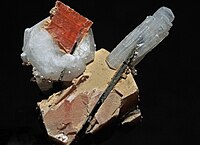
Photo from wikipedia
Abstract Myrmekites occurring in monzodiorite from the Meichuan pluton in the Dabie ultrahigh-pressure metamorphic belt were investigated. The petrographic evidence demonstrates a metasomatic origin for myrmekite formation at the scale… Click to show full abstract
Abstract Myrmekites occurring in monzodiorite from the Meichuan pluton in the Dabie ultrahigh-pressure metamorphic belt were investigated. The petrographic evidence demonstrates a metasomatic origin for myrmekite formation at the scale of individual alkali feldspar grains, and that the myrmekitic quartz and plagioclase matrix are generated simultaneously replacing precursor feldspar. Energy-dispersive X-ray spectroscopy and electron microprobe analysis indicate a low anorthite content in the narrow rim of host plagioclase near the myrmekite–alkali-feldspar interface. The Ca2+, Na+ proportion of hydrothermal fluids replacing precursor alkali feldspar is 1:5.4, calculated from the anorthite content of the inner part of the host plagioclase and the neighbouring alkali feldspar. Electron back-scattered diffraction was used to identify the crystallographic orientation of the myrmekitic quartz, plagioclase matrix and the precursor alkali feldspar. The crystallographic orientation relationships (110)Kfs//(11$\bar{2}\bar{1}$)Qtz, (20$\bar{1}$)Kfs//(11$\bar{2}$1)Qtz and [11$\bar{2}3]$Qtz//[001]Kfs between myrmekitic quartz and adjacent alkali feldspar were obtained from statistical analysis. No clear crystallographic orientation relationship between quartz and plagioclase was found. The growth of myrmekitic quartz is constrained by the precursor alkali feldspar rather than the simultaneously crystallised plagioclase. This research is helpful for understanding the intergrowth mechanism during metasomatism.
Journal Title: Mineralogical Magazine
Year Published: 2021
Link to full text (if available)
Share on Social Media: Sign Up to like & get
recommendations!